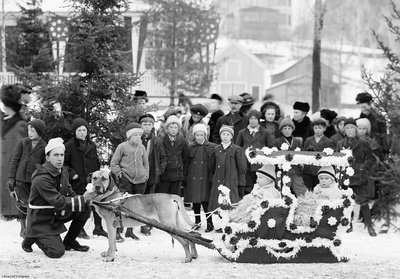 Winter Carnival Parade c.1917, Natalie Leduc album.
Winter Carnival Parade c.1917, Natalie Leduc album. 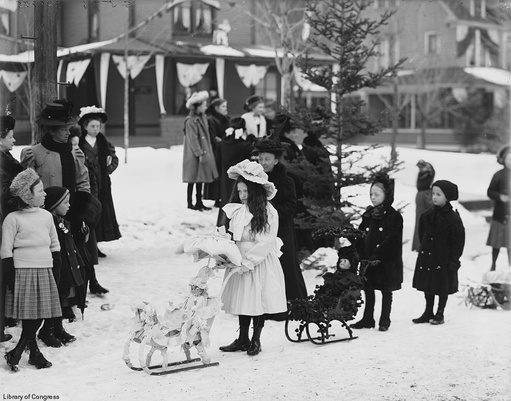 Winter Carnival Parade, 1909 Each winter the village of Saranac Lake holds what has become the oldest winter carnival in the eastern United States. 1
Winter Carnival Parade, 1909 Each winter the village of Saranac Lake holds what has become the oldest winter carnival in the eastern United States. 1
"The Pontiac Club of Saranac Lake held a fancy dress winter carnival on Flower Lake on the 17th," wrote the Plattsburg Republican on February 25, 1897. "About two hundred people gathered to witness the hockey match. The evening session was the most pleasing of all, about three hundred men, women and children being there in some kind of fancy costume." Small as it was, and not previously announced in the Plattsburgh press, the carnival was successful enough to be repeated in an expanded version the following year.
By the second year it was a much bigger event and attracted thousands of onlookers for days of parades and public events, including fireworks over a spectacular Ice Palace on the shore of Lake Flower. The tradition has continued with some interruptions to the present day.
See History of the Winter Carnivals for a detailed list of carnival elements by year.
Adirondack Daily Enterprise, February 1997
The origins of Saranac Lake's Winter Carnival
Village's premiere event had modest beginnings
Saranac Lake's first Winter Carnival was held in 1897. The year was no coincidence, but the result of a build-up of publicity for these festivities held elsewhere. In 1896, major ice palaces were built in three different cities - St. Paul, Minnesota; Quebec, Canada; and Leadville, Colorado — the most ever built in one year. In Saranac Lake — even devoted as it was to the care of tuberculosis patients — interest was high in festivities, culture and outdoor sports.
The first North American ice palace had been built in Montreal in 1883, according to "Ice Palace" by Fred Andenes and Ann Agranoff.
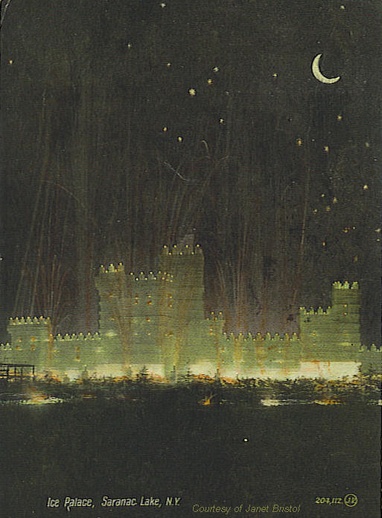 Fireworks over the Ice Palace, 1901
Fireworks over the Ice Palace, 1901
It was designed by architect A. C. Hutchison, who also planned the four later Montreal palaces. The 1884 event featured an official composite photograph, a hockey tournament, curling bonspiel or tournament, trotting races, lacrosse on skates, skating races, a snow-shoe steeplechase and a parade of sleighs. To climax a torchlight parade by snowshoe club members, they "stormed" the ice palace. The 1885 carnival was a similar success, but in 1886, no carnival was held; the province of Quebec was quarantined because of a smallpox epidemic. St. Paul. Minnesota, threw its first carnival that year, and hired Montreal's architect to design its ice palace. In 1887 Montreal again hosted its carnival to great acclaim. Weather problems interfered with the carnival and palace of 1889, ending Montreal's best years. Revived in 1909 and 1910, the lovely ice palaces designed for these years by Theodore Daoust and built by professional builders were spoiled by weather problems. St. Paul also hosted carnivals in 1887 and 1888, with palaces designed by C. E. Joy. The following two years were too warm, but the carnival was held again in 1896, and revived in 1916 and 1917. America's entry into World War I ended plans for 1918, and St. Paul's next carnival was not celebrated until 1937. Leadville, Colorado, held its only carnival in 1896, with an ice palace designed by C. E. Joy of St. Paul.
1896
The annual meet of the ice trotting circuit, open to trotters and pacers, took place January 21, 22 & 23, sponsored by the Gentlemen's Driving and Trotting Association of Saranac Lake, which offered $1,000 in total prize money. When the races began, the Essex County Republican reported, "there were not less than a thousand strangers on the ice (probably on Lower Saranac Lake). The track was in excellent condition, and with the large field of horses entered, there was a week of rare sport for lovers of fast horses." The sponsoring club had "a well established reputation for fair dealings and honest racing." The meeting moved on to Tupper Lake, purse $600, which was "somewhat of a stranger to racing men," but "easy of access from Saranac Lake;" then to Port Henry, purse $700, where the races were held "on Lake Champlain, adjacent and convenient to the village, and ... trotted on a kite track, thus ensuring fast time and a good chance for spectators to see start and finish." Crown Point and Ticonderoga were the venues in succeeding weeks. On January 30, the same paper reported that "ice cutting (presumably commercial) on Lake Flower has begun, although the ice measures but eight inches"; that "two nights last week local talent crowded the opera house (a hall on the second floor of the old Harrietstown Town Hall) by minstrel performances"; and that "the races on the ice were a big success."
1897
The next January, 1897, the Republican announced two Saranac Lake events: "Horsemen will take notice that the entries for the Saranac Lake races close Saturday, Jan. 16. 1897," and "a grand musical festival at Saranac Lake, conducted by Prof. C. F. Hudson, is one of the promised events for February." The horse races were held January 20, 21 & 22. On the second day "the attendance was the largest ever seen here, numbering close to 3,000 people."
 A William Kollecker post card of an early Ice Palace.
A William Kollecker post card of an early Ice Palace.
Courtesy of Judith Briggs Watson and Barbara Briggs-Letson.
Historic Saranac Lake Collection, TCR #226."Mid-Winter festival" trumpeted the headlines on February 11. Held the week of February 15, the grand musical festival was sponsored by the Adirondack Musical Association, with a line-up of prominent residents and visitors as members, beginning with Dr. and Mrs. E. L. Trudeau, the village president and first citizen and his wife. It is unusual for that time that the list included wives as members, probably because of the festival's cultural emphasis. The 21st Infantry Orchestra from Plattsburgh Barracks, described as one of the best in the country, was engaged, as well as a full roster of singers. The stage held 200 musicians, who rendered the "Gloria" from Mozart's twelfth mass as their grand finale. The railroads ran special trains to the little wooden Saranac Lake station; the excursion rate from Plattsburgh was $1.50 round trip. The economic effect of visiting audiences on village merchants was cited as an important consideration. Though the stated intention was "to make this a permanent organization which shall continue each year." nothing was heard of the musical association after the first year of 1897.
Though they were large, festive, public events, neither the horse races nor the music festival were the germ of our modern Winter Carnival. That was the Pontiac Club Carnival, first celebrated in February 1897. Only the previous November, the Pontiac Club had been formed "to encourage outdoor sports and games." This was the debut of organized winter sports in the central Adirondacks, fully eight years before the Lake Placid Club stayed open for the winter of 1904-05.
Tuberculosis patients — who were staying in the village in greater and greater numbers — could enjoy the fresh-air activities as spectators, even if they could not actively participate. Such leading citizens as Dr. E. L. Trudeau, Robert H. Coleman, Walter C. Rice, Dr. E. R. Baldwin, the Reverend Walter H. Larom, and William L. Coulter were charter members of the Pontiac Club, which sponsored the carnivals for the first ten years. Its membership list was very similar to that of the music festival, though no wives were listed. The club raised $1500 to purchase land between River Street and Lake Flower, and cleared the natural ice in front for a hockey rink and skating oval, eight laps to the mile.
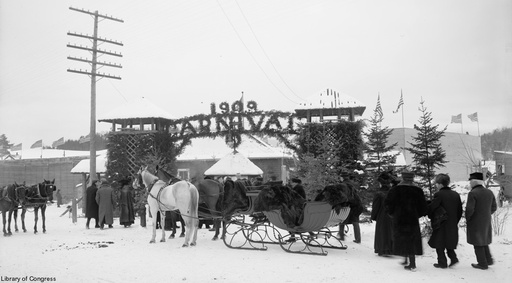 Outside Pontiac Rink, Winter Carnival, 1909 The only known contemporary account of the 1897 event is a small, after-the-fact item on the front page of the February 25 Republican: "The Pontiac Club of Saranac Lake held a fancy dress winter carnival on Flower Lake on the 17th. About two hundred people gathered to witness the hockey match. The evening session was the most pleasing of all, about three hundred men, women and children being there in some kind of fancy costume." Small as it was, and not previously announced in the Plattsburgh press, the carnival was successful enough to be repeated in an expanded version the following year.
Outside Pontiac Rink, Winter Carnival, 1909 The only known contemporary account of the 1897 event is a small, after-the-fact item on the front page of the February 25 Republican: "The Pontiac Club of Saranac Lake held a fancy dress winter carnival on Flower Lake on the 17th. About two hundred people gathered to witness the hockey match. The evening session was the most pleasing of all, about three hundred men, women and children being there in some kind of fancy costume." Small as it was, and not previously announced in the Plattsburgh press, the carnival was successful enough to be repeated in an expanded version the following year.
1898
The annual ice meeting was announced for January 18-20, 1898, to be held "on a mile kite track on Lower Saranac Lake" with a purse of $1200. On January 6, an account of the up-coming festivities was published under the headline:
"ICE CARNIVAL AT SARANAC LAKE: Winter Sports and Pastimes to Enliven the Adirondack Metropolis."
"The mercury at Saranac Lake Sunday morning registered 42 degrees below zero, but this exceedingly cold weather does not seem to lower the spirits of the inhabitants. On the contrary, it seems to be invigorating, for enthusiasm there over winter sports is just now at its height. The toboggan slide opened January 1st, and the Pontiac Club have concluded to hold an ice carnival January 21 and 22, the two days following the ice races. An ice palace and fort will be built opposite the club house.
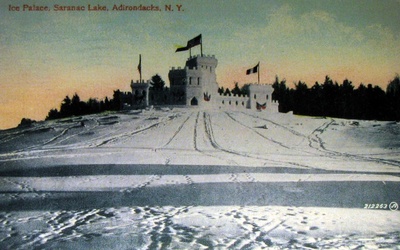 Ice Palace, labeled 1913. It is a hand-tinted postcard made from a photograph that the Library of Congress photo dates 1909..
Ice Palace, labeled 1913. It is a hand-tinted postcard made from a photograph that the Library of Congress photo dates 1909..
"The schedule of events for the carnival is expected to be as follows:
"Friday, January 21, afternoon: Parade of decorated sleighs. Evening, opening of ice palace, grand illumination, skating carnival in fancy costumes.
"Saturday, January 22, afternoon: Exhibition of skating, snow-shoe and skating races. Evening: Pyrotechnic display while storming the ice palace.
"It is expected that excursion rates will be obtained from the railroad companies."
This article is full of interesting information. The mention that the ice carnival would be held on "the two days following the ice races" establishes the association of the two events. The remark that "an ice palace and fort will be built opposite the club house" is the first evidence that the Pontiac Club had built its club house, roughly where modern ice palaces stand on the shore of Lake Flower. Though the site has become a part of the state boat launch, the club is commemorated in the name of nearby Pontiac Bay, which has been partially filled and grown smaller since its days as a speed-skating venue. The array o first-year activities, especially the expression "storming the ice palace." suggests that the committee had used the program from Montreal or another Winter Carnival as a model. That general outline is still followed: opening with a parade and initial lighting of the ice palace, and ending with "storming" — a mock attack on the palace - though the schedule has expanded from two days to 10, and professional fireworks have replaced torches as ammunition.
In 1898 the trotting races began on January 18, "an ideal winter's day," with the track in good condition. Attendance on the first day was over 1000, with predictions of a much larger crowd the next day if the weather held. In one race, the horses were "so evenly matched that the race could not be finished today and had to go over until tomorrow morning, after five heats had been trotted."
But the carnival was apparently put off on account of warm weather, for in a Saranac Lake column datelined January 31, it was clear that the event had not yet been held. The paper reported that "Sunday the mercury dropped to thirty below." Further, "The whole town is on the qui vive. The streets are filled with balsam, bunting and colored lights. The castellated fort has a medeaeval (sic) look, and the donjon by the Riverside (Inn). Much is to be brilliantly illuminated, will be a few attractions of the great fete." Also, "Mr. G. Whitman has had his store moved down to the Pontiac Club House, where he intends to sell confectionary, fruits and dainties during the carnival." Coverage ended with the remark. "We hope that the proprietors and correspondents of the PRESS will take in the carnival this week."
"We learned to skate early in the Adirondacks, and the Pontiac Club gave every kid a chance at the sport," wrote Bruce Coulter about his childhood in Saranac Lake at the turn of the century. "Skaters from all over the world came to compete in the international championships at the Pontiac Club, particularly during the Carnival, that enchanting time when there were parades, hockey games, races, and a spectacular finale at the Ice Palace, a fabulous structure built of blocks of ice, designed by our papa."
An "ice fortress" was introduced this second year of the carnival as the symbol of winter and gathering place for the climax of the event Ice palaces in Montreal and St. Paul were designed by professional architects, and Saranac Lake's was no exception. This work was described in an 1898 carnival souvenir edition of the Adirondack Enterprise:
"The first great success of the management was in the design and completion of the ice fortress. The plans for the structure were drawn by Architect William L. Coulter and he, assisted by Mr. Wilbur Sanders, superintended the work of construction. The fortress was about 100 feet in length and 50 feet in height, and, when illuminated presented a very beautiful and imposing appearance. The work of erection was carried on under great difficulties because of the January thaw and the committee should be congratulated on the signally successful completion of a seemingly endless task." The January thaw probably explains why the carnival was postponed.
Where the idea of an ice palace came from has never been determined. Saranac Lake had a number of Canadian residents who were likely familiar with such structures built in Montreal, and Coulter was probably familiar with them from a visit he had made in 1896 to St. Paul. Whoever made the suggestion, it reached a receptive audience among the members of the Pontiac Club, but it might never have been realized if a professional architect had not recently taken up residence.
From a close study of historic photos of ice palaces, characteristic patterns emerge. The masses of all the early buildings were broken-up forms of multiple towers — almost always square in plan — and walls of different heights After the first year, long cruciform recessed alcoves were used to break up a flat surface, instead of piercing the wall with windows, which promote wind erosion. The towers and walls were topped with separate ice blocks forming lacy battlements, and these were lighted with candles or electric lights on each one and sometimes between each one. The whole palace was decorated with flags flying from each tower, mounted on the walls in crossed pairs, and sometimes strung between towers or flag pole
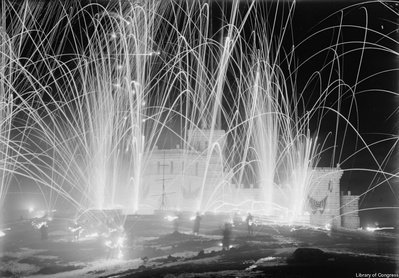 Storming the Ice Palace, dated 1909 by the Library of Congress.it. The Essex County Republican reported, on January 11: "Another Ice Carnival. The Pontiac Club, of Saranac Lake, are preparing to get up a grand winter carnival. One of the features is to be a toboggan slide."
Storming the Ice Palace, dated 1909 by the Library of Congress.it. The Essex County Republican reported, on January 11: "Another Ice Carnival. The Pontiac Club, of Saranac Lake, are preparing to get up a grand winter carnival. One of the features is to be a toboggan slide."
On January 18 the paper elaborated: "An Ice Carnival. Saranac Lake is making great preparations for its annual ice carnival to be held week after next, Jan. 30 to Feb. 2. The carnival is held under the auspices of the Pontiac Club, and among the attractions are a magnificent ice palace or fortress, built out of blocks of solid ice. The tower being forty feet high. The illumination of this fortress will be a beautiful spectacle. A parade of artistic and gorgeously decorated floats will be another attractive feature. Other attractions will be a masked ball, skating carnival, hockey games and other winter sports. A large attendance is expected from the cities."
Finally, this extensive coverage appeared on Jan 25: "MID-WINTER IN THE ADIRONDACKS. Plans for the Great Carnival at Saranac Lake.
"The mid-winter carnival al Saranac Lake is attracting the attention of all persons in the State who have ever visited the delightful resort in summer or winter. The carnival is under the auspices of the Pontiac club and combines the interest and efforts of all the citizens of Saranac irrespective of the club membership and the visitors from outside who are there. Support is also contributed by residents of main eastern cities who during the year go to Saranac to enjoy the delights of the mountains, lakes, forests and streams.
"The plans of the carnival are unfolding. As an incentive the committee on parade offers liberal prizes for the best decorated and most original floats which appear in the parade.
"The construction of the ice palace will commence early this week. The work will be done under contract. The proposed fortress will be similar in many respects to that of last year. It will be built of cakes of ice twelve to fourteen inches in thickness and of uniform length. There will be a central tower forty feet in height and there will also be two smaller towers, one at either end of the wings. These with the large battlements and alcoves will give the entire creation a truly massive appearance.
"The illumination of the palace and the storming of same will be on a larger and more elaborate scale than anything of its kind ever before attempted in this section.
"Neilson, who charmed the spectators at last year's carnival, will again be present. Miss Cummings, of Minneapolis, will also appear in fancy and figure skating.
"A fancy dress carnival will be held on the second night and a well-known costumer from New York will be in attendance from whom can be obtained suitable costumes for a nominal sum.
 Contestants in the costume skating event in front of the viewing stands at Pontiac Bay.
Contestants in the costume skating event in front of the viewing stands at Pontiac Bay.
Courtesy of Judith Briggs Watson and Barbara Briggs-Letson"The subscriptions of this year exceed those of all previous seasons and evidence that Saranac Lake citizens have awakened to a realization that the People's Carnival is a feature that Saranac Lake cannot well afford to slight.
"It is expected that within a few days a large list of entries will be received by the Saranac Lake Driving Association for the coming ice races, says the Saranac Lake Enterprise. Just what horses will start is not known, but it is almost an absolute certainty that some of the nest horses in this section will he in attendance. The large purses offered are certainly an incentive for large entries. The races will as usual take place on Lower Saranac Lake, in the vicinity of the Hotel Ampersand."
As had happened to Winter Carnivals in Montreal and St Paul, there was pressure to make each year's carnival bigger and better than the last. The economic motive is clear, and so is the continuing association with the ice trotting races. They were pronounced the best ever held there. . . . (On Friday it was bitter cold, the thermometer being ten degrees below zero, with a stiff breeze down the lakes," a condition familiar to residents of any era.
An amusing result of the 1900 carnival was announced on February 1: "Plattsburgh is getting jealous of Saranac Lake and is talking up an ice carnival." It was scheduled for Feb. 21, 22 & 23 that year, with many of the same arrangements and featuring the same fancy skaters as the carnival that had just been held in Saranac Lake.
In Saranac Lake, carnival was again held in 1901, but after that in odd numbered years only.
1907
In 1907 a very fine ice palace was built on Baker's Point next to Pontiac Bay in Lake Flower. It was described as "one of the tallest in carnival history,… designed by a professional architect and built by specially selected workers." The Board of Trade, comprised of "nearly every business man of consequence in the village" had taken over sponsorship of Winter Carnival from the Pontiac Club, implicit confirmation that there were business — as well as sporting — reasons behind carnival development, as had been acknowledged with the music festival. According to a rare surviving copy of "The Northern New Yorker. Carnival Edition," the 1907 Ice Palace Committee included W. L. Coulter, W. J. Callanan, and D. W. Riddle, all three of whom were professionally involved with construction management. Watching the Ice Palace being built must have been a great deal of fun for Coulter's two boys, Bill and Bruce, who could coast down Shepard Avenue from their house to the site al the foot of the hill, and boast to their friends of their father's work.
At that time the local ice industry provided enough competition that regular construction contracts were made for palace construction. Written bids were submitted: $475 from Michael C. Meagher, $502 from A. B. Lacy, and $675 from E. W. Norman".
The Board of Trade signed a contract with Meagher on January 9, with the firm of Coulter & Westhoff as architect. The work was described as "...clearing of ice, cutting of same in Lake Flower, and laying the same to construct an ice palace near the Pontiac Club, Saranac Lake," with a completion date of January 28. The price, and the size, of Saranac Lake Ice Palaces were proportionately smaller than the city palaces.
Ice palaces have always been built on various locations near Lake Flower, source of the building material. The first year that the palace was built on Slater Hill, on the site now occupied by North Country Community College's Administration Building, appears to be 1909. The Slater Hill site was continued in 1911 and 1913, and briefly revived in 1920, but the General Hospital was built there around 1921, and the palaces returned to the lake shore.
In 1909 the palace architect was likely Max Westhoff; his partner Coulter had died and William G. Distin, Sr., was away at Columbia University. Palaces built by Westhoff and Distin, after he returned in 1910, generally had a large, monolithic central form, round or octagonal towers, long slits for windows, and strong horizontal courses and cornices.
Saranac Lake clearly did not originate the idea of either Winter Carnivals or ice palaces; it simply followed the pattern of those established elsewhere.
The community's size, its remote location, and its nature as a haven for TB patients put it outside the mainstream, delaying some changes caused by outside forces such as the Depression. Though the Winter Carnival idea was abandoned in other places, and had a hiatus here between the world wars, it was revived in 1947-48. One hundred years later, this 19th century tradition continues in Saranac Lake.
Adirondack Daily Enterprise, February 13, 1987
Historian looks back at early Winter Carnivals featuring skating on Pontiac Bay and fireworks
As the time approaches for our 1987 Winter Carnival, it might be fun to take a backward glance at some carnivals of old. Carnivals began in 1898 when a group of local enthusiasts decided to break the winter doldrums with a little entertainment and the Mid-Winter Ice Carnival was born. Fist sponsored by the Pontiac Club, from the very beginning the affair was a huge success. At one time it was believed that ours was the very first winter carnival to be held in North America, but research has proven otherwise. Montreal featured one in 1883, St. Paul, Minn., in 1886, and Leadville, Colorado, in 1896. Even more surprising is that a somewhat demented Russian Empress had an ice palace constructed as early as 1739. Be that as it may, all of us can be justly proud of our own winter carnivals, both past and present.
As the men from Camp Adirondack are cutting ice blocks in the bay of Lake Flower, to build this year's palace, many senior citizens can recall when this same site was the location of an annual event which, in the early 1900's, drew world wide attention.
It was here that the International Speed Skating Races were held on the famous old Pontiac Skating Rink, and it was here that our hometown hero, Ed Lamy, broke all records to become the World's Champion speed skater. The races were then the very highlight of the Winter Carnival and drew large crowds that out-numbered the population of the village. On "Lamy Day" as many as 5,000 spectators would fill the grandstands at a time when our residents totaled only about 3,000.
Let's try to remember what the old Pontiac Rink looked like during an early carnival on race day. The ice palace was built atop nearby Slater Hill where it commanded an impressive view of the spectacular skating oval on Pontiac Bay. In the morning the crowds would begin to wend their way along River Street dressed in fur coats and carrying blankets to ward off the cold when seated on the wooden benches in the grandstands. Some gentlemen were also known to carry silver flasks in their coat pockets which contained a certain pre-prohibition liquid to serve as a further insurance against the frigid temperature.
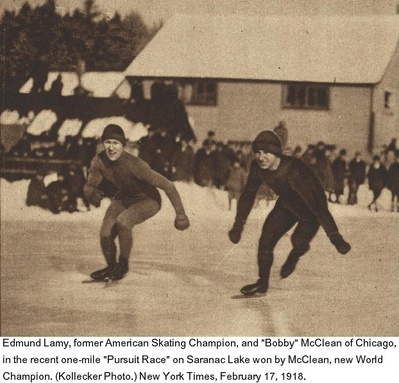 Ed LaBounty's sleigh, with bells jingling from the horse trappings, would carry patients from the cure cottages wrapped in gayly colored Hudson Bay blankets to join the spectators. The pedestrians would cross the street to enter the alleyway between the Boy's Club and the Curling Rink which terminated at the ticket gate where that staunch bulwark of the local constabulary, Bill Paye, kept law and order. Bill was known to look the other way whenever some ticketless lad made entry by climbing over the fence.
Ed LaBounty's sleigh, with bells jingling from the horse trappings, would carry patients from the cure cottages wrapped in gayly colored Hudson Bay blankets to join the spectators. The pedestrians would cross the street to enter the alleyway between the Boy's Club and the Curling Rink which terminated at the ticket gate where that staunch bulwark of the local constabulary, Bill Paye, kept law and order. Bill was known to look the other way whenever some ticketless lad made entry by climbing over the fence.
Inside the skating house the contestants took over both the boys' and girls' dressing rooms which were crowded with rub-down tables where the trainers massaged leg muscles. The aroma of strong liniments permeated the air as the racers indulged in some good natured bantering. Upstairs, in the open balcony, Roy Lobdell led the band in stirring renditions of "Carnival at Venice" or the "Washington Post March" while skaters, between events, would slowly circle the track wearing their warm-up bathrobes with scabbards clasped behind their backs.
The one-sixth mile was freshly flooded and the polished ice oval reflected the colorful flags and bunting which decorated the area. In the stands hot dogs were being hawked at ten cents each, with or without mustard, as the spectators studied their programs.
When the first race was called all eyes were on the starting line as the crowd awaited the crack of the starter's gun. Each could follow the position of a favorite entry by the bright color of his skating suit, but Ed Lamy and Ross Robinson always wore solid black. Inside the track oval was the hockey pen where the referee cruised around to assure full compliance with the racing rules. A hand-held dinner bell clanged out the announcement of the final lap as the finish-tape was quickly drawn across the line directly in front of the main grandstand Whenever Ed Lamy broke the tape there was a great burst of applause.
The international events ran for three days with both heats and finals spaced so that each day provided a program of mixed interests. Age group classifications moved upward in two-year brackets from the ten-year-olds to the seniors. Each age division was always well represented with local entries as our village turned out many outstanding skaters over the years.
In 1926 Clas Thunberg, the world champ from Finland, came here to meet Charles Jewtraw in a match race. Jewtraw, from Lake Placid, was a gold medal winner at the first Winter Olympic Games held in France in 1924 but was no match for Thunberg who won easily. As an eight-year-old I was privileged to skate around the rink holding hands with Thunberg who thoroughly enjoyed children.
Phil Perry acted as interpreter for his fellow patriot from Finland during his stay at Saranac Lake. Unfortunately the following year, 1927, proved to be the last year that the Internationals were held in our village. Another early event which has also disappeared from the program was the very popular costume skating party held at night under the lights at the Pontiac Rink. This was one activity in which all could take part and, in fact, nearly everyone did. It was a happy occasion exemplifying, as it did, the true spirit of carnival.
For the duration of the celebration the village garbed itself in festive array. Residential homes and business blocks as well were bedecked with draped red, white, and blue bunting. At Berkeley Square a pyramid of ice was illuminated with colored lights while bowers of evergreens spanned Main Street and Broadway. A Carnival Committee awarded prizes for the best decorations and 1915 listed the following winners:
 First prize cup, Decorated Float, 1905
First prize cup, Decorated Float, 1905 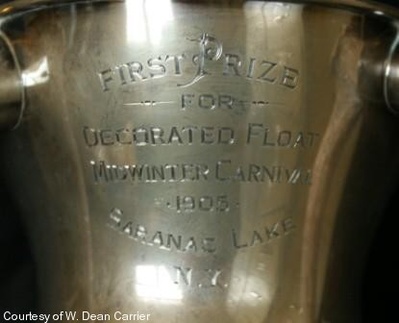 First prize cup, Decorated Float, 1905, won by Trombley and Carrier RESIDENTIAL
First prize cup, Decorated Float, 1905, won by Trombley and Carrier RESIDENTIAL
1st prize — Dr. Lawrason Brown 2nd prize — Dr. Charles Trembley 3rd prize — Kenneth Goldthwaite
COMMERCIAL
1st prize — Adirondack National Bank 2nd prize — Henry P. Leis 3rd prize — The Santanoni
Two of the most popular events were the float parade and the storming of the ice palace. With slight variations these two attractions remain the main events of today's carnival. The early floats were, perforce, horse drawn while today's floats are, of course, motorized, The early stormings of the ice palace, pitched an attack army versus the defenders of the citadel. The besiegers stormed up the hill firing rockets and Roman candles while the palace guard answered in kind with their own arsenal of fireworks. Finally mortars shot off the ultra-high exploding bombs which showered down a dazzling pyrotechnic display on the scene below. Today this human element has been eliminated (for safety reasons) but the spectacular fireworks display re mains to be a highlight of the carnival program.
According to the 1907 Carnival Edition of the Northern New Yorker the founding of the Pontiac Club in 1896 was Saranac Lake's most important manifestation of public spirit. "Villagers and visitors had never before united to work for the advancement of Saranac Lake. Our first Mid-Winter Carnival of 1898 was a further manifestation of this principal of community accomplishment. May we continue to operate in this premise for the next 90 years.
 Gray Blanchet on a ladybug float, probably for the 1917 Winter Carnival parade. Courtesy of Sarah Blanchet. Adirondack Daily Enterprise, October 8, 1985
Gray Blanchet on a ladybug float, probably for the 1917 Winter Carnival parade. Courtesy of Sarah Blanchet. Adirondack Daily Enterprise, October 8, 1985
Authentic ice palaces distinguish Carnival
Each winter the village of Saranac Lake holds what has become the oldest winter carnival in the U.S.A. Lasting in recent years for five consecutive days, usually in February, the event begins with a coronation ceremony for a King and Queen, who are chosen from community nominations, their names kept secret until crowned, and ends with a spectacular fireworks display at the ice palace constructed for the carnival.
In between are about two-dozen separate events many of which are competitive and include almost all typical winter sports, as well as dances, music fests, plays and lectures, and a parade. Lighter motifs include snowshoes softball, inner tube races, and broom hockey.
For most of a week the carnival dominates the scenic village of about 5,500 people, many of whom wear three inch carnival buttons created for the last 5 years by well known syndicated cartoonist Garry Trudeau, creator of the sharp edged comic strip "Doonesbury." (Trudeau is a great-grandson of Dr. Edward L. Trudeau, who came to Saranac Lake in 1876 and turned the village into a haven for tubercular invalids. In 1985 his grandson Dr. Frank Trudeau was named Grand Marshall of the parade and the Trudeau Institute's elaborate float, including a fire-breathing dragon, was judged best overall).
The 1985 carnival was billed as the 88th annual, and a look at the history of the event will show that it has undergone a variety of changes through the years. (One must allow for the hyperbole of community spirit regarding "88th." The carnival is referred to as bi-annual in a 1920 publication by the Village Board of Trustees, for example, and was also not held in some Depression and World War years). The creation of an ice palace each year has provided a thematic cohesiveness that is probably the carnival's biggest claim to fame.
In this regard, Fred Anderes and Ann Agranoff, authors of a recent book called Ice Palaces, are able to state with some authority that Saranac Lake has the only remaining ice palace actually made of blocks of ice, rather than snow, which is allegedly cheaper to construct.
But whereas cities such as St. Paul (which also claims the oldest winter carnival) and Quebec have in recent years run up costs as high as $18,000 and $80,000 respectively, Saranac Lake keeps costs minimal (probably under $5,000) by using volunteer labor from nearby Camp Gabriels, a minimum security prison, and local volunteers. For 1985 special mention must be made of William Madden III and Tom Hyde, who worked daily engineering the month-long construction job.
One measure of the enormity of the ice palace is that 1985's weighed 1,440,000 pounds. (A contest is held to guess the weight — winner Kathy Steinbrueck of Saranac Lake underestimated by 39,375 pounds.)
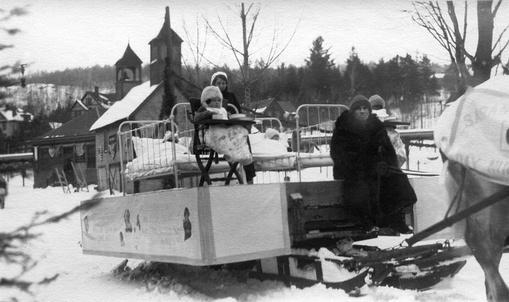 An early parade float. Courtesy of Judith Briggs Watson and Barbara Briggs-LetsonMadden's value to the palace project has been enhanced for the last four years by his donation of the services of a modern mobile crane, for which this year he rightly suggested he be paid. Since the palaces of recent years are much smaller than some of those of years gone by, one marvels at the logistics of early construction without a crane, but the method has remained essentially the same.
An early parade float. Courtesy of Judith Briggs Watson and Barbara Briggs-LetsonMadden's value to the palace project has been enhanced for the last four years by his donation of the services of a modern mobile crane, for which this year he rightly suggested he be paid. Since the palaces of recent years are much smaller than some of those of years gone by, one marvels at the logistics of early construction without a crane, but the method has remained essentially the same.
A mobile circular saw about three feet in diameter is taken on to the ice in shallow Pontiac Bay of Lake Flower next to River St., where the ice may be frozen to a thickness of about a foot, and blocks 22" x 44" are cut and floated along an open water channel cut just wide enough for them to a conveyor about 75 feet from shore which raises the blocks about ten feet. The blocks are then stick poled down a skidway about 75 feet long to the site of the palace where the crane lifts them with tongs into place and slush is mortared into the cracks.
Chippers are used to nudge blocks into correct position or to free frozen blocks left overnight, and a shaver is used in the leveling process of each tier. An early photo shows a vertical lift, like an elevator for the ice blocks, in place of the modern mobile crane.
The location of the bases for turrets and walls is surveyed and laid out ahead of time. The carnival theme for 1985 was "The Magic Kingdom" and the palace reflected that in being a medieval-like castle with an asymetrical design, topped with the customary colorful banners. (For the 1910 carnival and others of that era an ice pyramid was also built on Berkeley Square at Main and Broadway; in 1960 a low stockade-like palace was built. Other past palace sites have included Slater Hill.)
According to current designer Tom Hyde, the old palaces were built by separate groups of people working on discreet sections which were then unified by connecting walls.
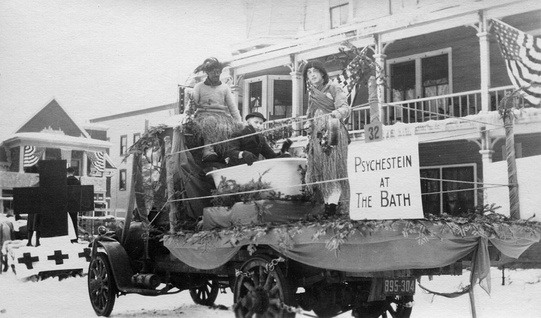 A strange parade float! Courtesy of Judith Briggs Watson and Barbara Briggs-LetsonLocal historian Barbara Parnass states the very early palaces were designed by architects and constructed by professional ice handlers who then sold the ice after the carnival for train shipment to various cities.
A strange parade float! Courtesy of Judith Briggs Watson and Barbara Briggs-LetsonLocal historian Barbara Parnass states the very early palaces were designed by architects and constructed by professional ice handlers who then sold the ice after the carnival for train shipment to various cities.
The first ice palace was built in 1898 by the Pontiac Bay Club (Dr. Edward L. Trudeau helped in its formation), and measured 100 feet by 50 feet, and was on Baker's Point. That year the Adirondack Daily Enterprise published on March 14 a Winter Carnival "Souvenier Edition" in summation of the carnival and described the " . . . grim, massive facade of the ice palace, its walls brilliant with soft radiance, and surmounted with hundreds of colored lights and gay-hued banners; above, myriad of lights . . . Never was the cosmopolitan nature of Saranac Lake better illustrated than during our Carnival."
The Pontiac Club was organized in 1886 to promote sports and social life, and had a clubhouse, toboggan slide, an outdoor skating rink near the site of the present ice palace. At the first carnival two hockey games against Malone, "fancy dress" and speed skating, and a one-mile snowshoe race were held on February 2, and W.F. Mullarkey of Plattsburgh jumped 31 and one-eighth inches backwards for a new record.
The first carnival's "fancy dress" skaters set a tone similar to that of the most recent carnival, "only to be compared with our childish ideas of fairyland," according to the Enterprise writers. Included were Santa Claus, Uncle Sam, Little Red Riding Hood, clowns, convicts, Dutch and Italian girls, gypsies and Pocahontas.
The following day the parade included 30 floats and 20 sleighs, and wound through the village over at least a dozen streets.
Among the marchers were the 21st Infantry Band and the Adirondack Guides' Association; the winning float was of an Adirondack camp, whiskery men dressed as guides, a lean-to draped with deer skins, all on a horse drawn float.
In 1909 coasting races down a slide maintained by the Saranac Lake Country Club were held at Baker Mountain. The course ended on a level straightaway on Moody Pond and the contestants were reported reaching speeds of 60 mph.
The year 1911 included an "event extraordinary; speed demonstration of the first perfected AERO ICE BOAT, designed and operated by Mr. Charles J. Swain, Quaker City Motor Club, of Philadelphia, Pa."
The Adirondack Daily Enterprise Racing Final rotogravure Carnival Edition for February 4, 1915, lists Floats Class A, First — "The Red Cross Ship" entered by Adirondack Cottage Sanitarium. Other floats were entered by Brighton, Harrietstown Grange, and Paul Smith's Electric Light, Power & Railroad Co. Other parade entrants included a decorated sleigh, mounted Norsemen, decorated cars, and dog teams.
Floats totaled 75, although some from Bloomingdale and Harrietstown and Brighton were unable to come because of deep snow the night before. The parade was a mile long including a Children's Parade.
The 1915 Carnival Edition reviewed past float winners and stated that the Adirondack winter, the Adirondack life, or the Saranac Lake idea usually won except in 1905 when "The Voyage of Columbus" took the prize. The "Saranac idea" is described as the battle against the white plague, or tuberculosis, and a float symbolizing this called "The Conflict" took top honors in 1911. Decorated automobiles probably appeared first in 1911, also.
Decorations in the village were more lavish than now, and buildings were festooned with bunting and flags. One year the storming of the ice palace was done with colored torches by three divisions: schoolboys, firemen, and guides, all equipped with fireworks. In 1917 the palace was "defended" by M. Wagner and Co. in which "twelve inch bombs (are) sent aloft, bursting into primrose, violet, pansy, heliotrope and laburnum effects."
Also the same year the children's parade carried the theme "Mother Goose Pageant," and some interesting artifacts survive in the Adirondack Collection of the Saranac Lake Free Library from this carnival.
The first is an artist's watercolor sketch in brilliant orange and blue, unsigned, of a lady bug. It is a good possibility the sketch is the work of Mildred Blanchet, wife of Dr. Sidney Blanchet, according to Miss Esther Mirick of Saranac Lake, who was Dr. Blanchet's secretary and viewed the 1917 parade, held the same year she graduated from high school. Mrs. Blanchet also designed the harlequin girl design for the first carnival — a logo-like design used on the program, for example.
The second is a photograph in a personal scrapbook about 3" x 5", owner unknown, showing the actual float produced, presumably, from the sketch. In the scrapbook pasted next to the photo, is a small newspaper clipping that says, ' "Entered by F.E. Hull." Lady Bug, which was float 11, was entered by F.E. Hull, assisted by John Weir. The float depicted the verse "Lady Bug, Lady Bug, fly away home." The bug was a huge plaster piece with red and black coloring. Master Buddy Bosworth rode the lady bug and was dressed in a costume of blue with white wings." '
In addition to the news clipping next to the black-and-white photo, a handwritten notation in ink says, "The Bug was a brilliant orange which of course takes dark and the little suit blue."
In the years to come after the first carnival the floats, especially, grew in lavishness, and gave a Mardi-Gras elegance. The role the carnival played in the social and recreational life of the village was probably greater because of the village's relative isolation then and fewer competing winter events both in Saranac Lake and nearby towns. In 1907 The Northern New Yorker Carnival Edition stated "the carnival neither begins nor ends on the dates fixed. For six weeks before the entire village is preparing for it . . . a month is taken up by the gayeties that naturally follow the event so that it provides entertainment for an entire winter."
But as this role and perhaps the sheer number of participants may have fallen off, other developments have helped to assure the carnival's future, most notably for 1985 the addition of the Cadbury Company as a sponsor. Thus in the parade the Saranac Lake Chamber of Commerce float was staffed with people throwing Wispa candy bars, a product of the Cadbury Co., to the crowd. This commercialization didn't seem to detract from the carnival very much. Some outside funding may be vital, and it certainly doesn't hurt crowd appeal that the sponsor is a candy manufacturer. (Sled dog races were sponsored by Alpo Petfoods two weeks before the carnival. Comercial subsidy may be a fact of life for events, that are essentially free to the public and yet boost tourism in the community.
Sue Dyer, Director of the Saranac Like Chamber of Commerce, feels the carnival's future is geared to a cycle of waxing and waning interest, in that "it grows like Topsy. Every once in a while somebody will revive it."
 Celeste Holm
Celeste Holm 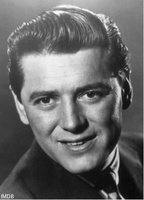 Gordon McRae In 1970 that "somebody" was Dyer herself and Barbara Chapin. Prior to that the carnival was in debt, although not for lack of trying — various celebrities had been brought in, including in 1957 Don McNeill and his Breakfast Club, a radio show which was broadcast from Saranac Lake for a week, and in Dyer's own time, movie stars Celeste Holme and Gordon McCrae. But these stars, who usually performed at the Rotary Show at the Pontiac Theatre before it burned, were costing four or five thousand dollars.
Gordon McRae In 1970 that "somebody" was Dyer herself and Barbara Chapin. Prior to that the carnival was in debt, although not for lack of trying — various celebrities had been brought in, including in 1957 Don McNeill and his Breakfast Club, a radio show which was broadcast from Saranac Lake for a week, and in Dyer's own time, movie stars Celeste Holme and Gordon McCrae. But these stars, who usually performed at the Rotary Show at the Pontiac Theatre before it burned, were costing four or five thousand dollars.
Dyer and Chapin helped form the Winter Carnival Committee and began the radio auction which is still, along with the Trudeau buttons, a major fundraiser for the carnival. A charitable "paper" trust called "The Society for Promotion of Winter Carnival" was formed to be a legal governing body and accept monies on behalf of the carnival. Dyer remembers that suddenly "nothing was free" (except the events open to mass public attendance), but this was what was called for to put the event into the black.
Dyer recalls that the mix of local and national celebrities has varied, and that one year there was a local king and queen as well as a Miss Rheingold. A number of Miss Rheingolds have appeared; in 1964 Celeste Yarnall filled that role, and joined singer Julius LaRosa of "The Arthur Godfrey Show" fame. In 1967 actress Judy Carne, was paired with football player Charles Gogolak.
In the last 20 years Dyer recalls only one year there was no ice palace because of lack of ice, and a snow palace was built.
Recent years have included, at the carnival's end just before the fireworks, a color slide show projected onto a screen hung high on the ice palace, a type of "instant replay" of the carnival's events and people in the days preceding. Even this touch has precedent, from 1915: "W.F. Kollecker, the photographer, made over 300 photographs of the parade, and had prints on sale that same evening. The photographer attracted instant attention."
Maybe one of the photos would have assisted the hapless person who had to place this ad that year: "LOST, on route of carnival parade, a silver and glass pocket flask."
Acknowledgements: Thanks for help in preparing this article to: Don Benedict, Janet Decker, William Doolittle, Sue Dyer and Esther Mirick.
(Reprinted by permission of the Franklin County Historical Society.)
See also
- History of the Winter Carnivals - A year-by-year list of Winter Carnivals
- Saranac Lake Summer Carnival
External links
- 1905 New York Times article about Winter Carnival in Saranac Lake
- Saranac Lake Winter Carnival website
Footnote:
1. The 1886 Winter Carnival of St, Paul, Minnesota was the first winter carnival in the United States.
Comments
Does the St. Paul carnival continue?
2013-02-05 15:02:59 I would like to see a picture of Pontiac hockey team with goalie Bill Paye In the net.—1907——1920 —74.71.129.61
2013-02-20 10:44:02 So much information! Really helped with a research project! —208.125.106.90


